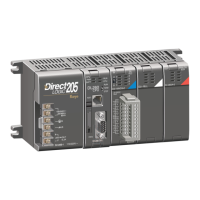DDiirreecctt
NET Port Configuration
In DirectSOFT, choose the PLC menu, then Setup, then “Secondary Comm Port”.
• Port: From the port number list box, choose “Port 2 ”.
• Protocol: Click the check box to the left of “DirectNET” (use AUX 56 on the HPP, then select
“DNET”), and then you’ll see the dialog box below.
• Timeout: The amount of time the port will wait after it sends a message to get a response before
logging an error.
• RTS On Delay Time: The amount of time between raising the RTS line and sending the data.
• RTS Off Delay Time: The amount of time between resetting the RTS line after sending the data.
• Station Number: To make the CPU port a DirectNET master, choose “1”. The allowable range for
DirectNET slaves is from 1 to 90 (each slave must have a unique number). At powerup, the port is
automatically a slave, unless and until the DL250–1 or DL260 executes ladder logic instructions
which attempt to use the port as a master. Thereafter, the port reverts back to slave mode until
ladder logic uses the port again.
• Baud Rate: The available baud rates include 300, 600, 900, 2400, 4800, 9600, 19200, and 38400
baud. Choose a higher baud rate initially, reverting to lower baud rates if you experience data errors
or noise problems on the network. Important: You must configure the baud rates of all devices on
the network to the same value.
• Stop Bits: Choose 1 or 2 stop bits for use in the protocol.
• Parity: Choose none, even, or odd parity for error checking.
• Format: Choose hex or ASCII formats.
Then click the button indicated to send the Port configuration to the CPU, and click Close.
DL205 User Manual, 4th Edition, Rev. B
4–34
Chapter 4: System Design and Configuration
1
2
3
4
5
6
7
8
9
10
11
12
13
14
A
B
C
D

